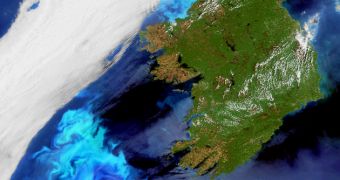The European Space Agency (ESA) has just released an amazing new image of a beautiful plankton bloom, which is currently taking place west of Ireland.
The bloom, which is the feature colored in electric blue, looks as if it was painted with the characteristic brush strokes of French Impressionist painter Claude Monet, officials at the agency say.
Swirling in the waters of the North Atlantic Ocean, off the western coasts of Ireland, the phytoplankton is easily visible from the Envisat satellite, which took this photo on May23, at a resolution of 300 meters.
The data was collected using Envisat's Medium Resolution Imaging Spectrometer (MERIS) instrument, which is basically an advanced “ocean color” sensor.
Phytoplankton is of great importance to marine ecosystems, as they represent the basis of the food chain in the world's oceans. They are nothing more than microscopic marine plants, drifting on the surface of the water as the winds and currents dictate.
Without them, no life would exist in oceans, seas and lakes. All other, more complex organisms somehow rely on the phytoplankton for their own survival, marine ecologists say.
The small organisms also play an important part in our planet's process of photosynthesis, due to the fact that they contain photosynthetic chlorophyll pigments.
One of the main traits phytoplankton has is the fact that it can contribute to transforming inorganic matter such as water, nitrogen and carbon into complex organic materials.
Additionally, they can also trap carbon dioxide from the ocean-atmosphere interface, carrying it to the bottom of the ocean as they dies. This means that those amounts of CO2 are captured and stored.
It is generally estimated that phytoplankton is responsible for eliminating roughly the same amount of CO2 from the atmosphere as all the plants on land do together.
In other words, they are the microscopic equivalent of massive rain forests and all sorts of other plants. Researchers say that this ability played an important role in oxygenating Earth.
This in turn allowed for the earliest life forms to develop into more complex organisms, which all require large amounts of oxygen to function.
Follow me on Twitter @TudorVieru

 14 DAY TRIAL //
14 DAY TRIAL //